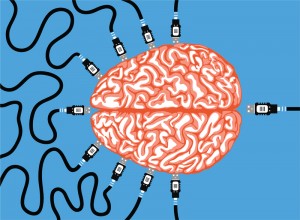 The brain-to-brain interface experiment of UW CSE’s Rajesh Rao continues to attract extraordinary attention.
The brain-to-brain interface experiment of UW CSE’s Rajesh Rao continues to attract extraordinary attention.
Discover features an in-depth explanation of the experiment and its implications, here:
“Finally, in August 2013, University of Washington scientists Rajesh Rao and Andrea Stocco succeeded in making one leap everyone was waiting for: A human-to-human brain-to-brain interface. By strapping one person into a non-invasive EEG helmet, and strapping the second into a transcranial magnetic stimulation (TMS) helmet, the researchers mind-melded themselves – for the sake of science.
“The experiment went like this: Rao and Stocco sat across campus from one another, watching the same video game. Rao, wearing an EEG helmet, was at the controls – but instead of using his hand to hit the spacebar to fire, he simply imagined moving his hand.
 “Every time he did this, with near-instantaneous speed, a computer converted Rao’s brain signals into a digital signal and beamed it to Stocco’s TMS helmet. That helmet converted the signal into a burst of magnetic stimulation delivered to the precise region of Stocco’s motor cortex that controlled his right hand. Stocco’s hand would then twitch involuntarily, tapping the spacebar and (sometimes) scoring a hit in the game.”
“Every time he did this, with near-instantaneous speed, a computer converted Rao’s brain signals into a digital signal and beamed it to Stocco’s TMS helmet. That helmet converted the signal into a burst of magnetic stimulation delivered to the precise region of Stocco’s motor cortex that controlled his right hand. Stocco’s hand would then twitch involuntarily, tapping the spacebar and (sometimes) scoring a hit in the game.”
Science focuses on the implications, here:
“Restoration of normal function has driven development of devices such as cochlear implants for deafness, deep-brain stimulators for Parkinson’s disease, and bionic eyes for the blind, but there has long been a fascination with using similar technologies to “neuroenhance” healthy individuals, helping them control emotions, improve memory and cognition, and even communicate wordlessly with others …”

